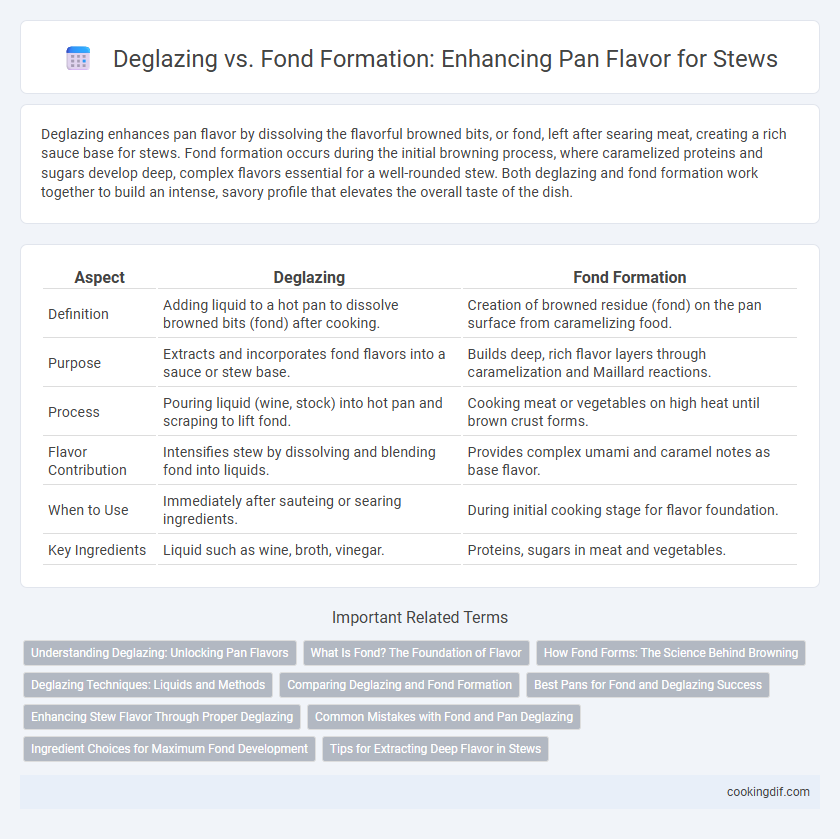Deglazing enhances pan flavor by dissolving the flavorful browned bits, or fond, left after searing meat, creating a rich sauce base for stews. Fond formation occurs during the initial browning process, where caramelized proteins and sugars develop deep, complex flavors essential for a well-rounded stew. Both deglazing and fond formation work together to build an intense, savory profile that elevates the overall taste of the dish.
Table of Comparison
| Aspect | Deglazing | Fond Formation |
|---|---|---|
| Definition | Adding liquid to a hot pan to dissolve browned bits (fond) after cooking. | Creation of browned residue (fond) on the pan surface from caramelizing food. |
| Purpose | Extracts and incorporates fond flavors into a sauce or stew base. | Builds deep, rich flavor layers through caramelization and Maillard reactions. |
| Process | Pouring liquid (wine, stock) into hot pan and scraping to lift fond. | Cooking meat or vegetables on high heat until brown crust forms. |
| Flavor Contribution | Intensifies stew by dissolving and blending fond into liquids. | Provides complex umami and caramel notes as base flavor. |
| When to Use | Immediately after sauteing or searing ingredients. | During initial cooking stage for flavor foundation. |
| Key Ingredients | Liquid such as wine, broth, vinegar. | Proteins, sugars in meat and vegetables. |
Understanding Deglazing: Unlocking Pan Flavors
Deglazing enhances stew depth by dissolving the fond, the caramelized bits stuck to the pan, releasing intense umami flavors. Using a liquid such as wine, broth, or vinegar to deglaze captures these concentrated flavors, infusing the stew with richness and complexity. Mastering deglazing transforms pan residue into a flavorful base, elevating the overall taste profile of stews.
What Is Fond? The Foundation of Flavor
Fond is the browned residue of caramelized bits and juices left in the pan after searing meat or vegetables, serving as the foundation of rich, complex stew flavors. Deglazing involves adding liquid to the hot pan to dissolve the fond, releasing concentrated taste compounds that enhance the stew's depth. Mastering fond formation and deglazing techniques intensifies the savory profile, creating a more flavorful and aromatic dish.
How Fond Forms: The Science Behind Browning
Fond forms through the Maillard reaction, a complex chemical process between amino acids and reducing sugars at high heat, creating rich, savory flavors essential for stews. When food is seared, proteins and sugars caramelize and adhere to the pan surface, developing the flavorful brown crust known as fond. Proper fond formation enhances depth of flavor in stews by providing a concentrated base that, once deglazed, incorporates these browned compounds into the cooking liquid.
Deglazing Techniques: Liquids and Methods
Deglazing enhances stew flavor by dissolving fond--the concentrated browned bits stuck to the pan--using liquids like wine, broth, or vinegar. Techniques involve carefully pouring the chosen liquid into the hot pan and scraping the bottom with a wooden spoon to release and incorporate the fond into the stew. Selecting acidic liquids such as red wine or apple cider vinegar intensifies flavor complexity, while stock or broth adds depth and richness.
Comparing Deglazing and Fond Formation
Deglazing enhances stew flavor by dissolving browned fond, the caramelized bits that form from searing meat, into a liquid base like wine, broth, or stock, creating rich depth and complexity. Fond formation occurs during the initial browning process, where proteins and sugars undergo the Maillard reaction, producing intense savory notes critical for a flavorful stew foundation. Comparing both, fond formation establishes the essential flavor base, while deglazing extracts and incorporates these concentrated flavors into the stew's liquid, elevating overall taste and mouthfeel.
Best Pans for Fond and Deglazing Success
Cast iron and stainless steel pans are ideal for fond formation and deglazing due to their excellent heat retention and even cooking surfaces. Nonstick pans typically fail to develop fond, which is crucial for building the deep, caramelized flavors in stews. High-quality stainless steel pans with a heavy base promote successful fond development, allowing concentrated flavors to be lifted during deglazing with wine, broth, or vinegar.
Enhancing Stew Flavor Through Proper Deglazing
Proper deglazing is essential for enhancing stew flavor by dissolving fond--the caramelized browned bits stuck to the pan--into the cooking liquid, enriching the stew with deep, complex flavors. Using a liquid such as wine, broth, or vinegar to deglaze releases these concentrated taste compounds, creating a flavorful base that integrates well with the stew's ingredients. Mastering this technique intensifies the stew's savory profile and elevates its overall richness without adding extra seasoning.
Common Mistakes with Fond and Pan Deglazing
Common mistakes with fond and pan deglazing include prematurely adding liquid, which cools the pan and prevents proper fond formation, and using excessive heat that burns the fond, creating bitter flavors. Another frequent error is insufficient scraping of browned bits, resulting in lost flavor potential and incomplete deglazing. Proper timing and technique in fond development and deglazing maximize rich, complex stew flavors.
Ingredient Choices for Maximum Fond Development
Choosing ingredients rich in natural sugars and proteins, such as caramelizing onions, garlic, and root vegetables, promotes robust fond formation that intensifies stew flavor. Using meats with higher collagen content like beef chuck or pork shoulder enhances fond through abundant browning reactions and gelatin release. Deglazing with acidic liquids like wine or stock lifts these browned bits, incorporating concentrated umami and depth back into the stew, maximizing flavor development.
Tips for Extracting Deep Flavor in Stews
Deglazing involves adding liquid to a hot pan to dissolve browned bits known as fond, which are packed with concentrated flavors essential for rich stews. To extract deep flavor, use wine, broth, or even vinegar to lift the fond while scraping the pan's surface to incorporate those caramelized particles into the stew base. Maintaining high heat at the start of cooking encourages fond formation, which serves as a flavorful foundation that intensifies the stew's complexity when deglazed properly.
Deglazing vs Fond Formation for pan flavor Infographic

 cookingdif.com
cookingdif.com